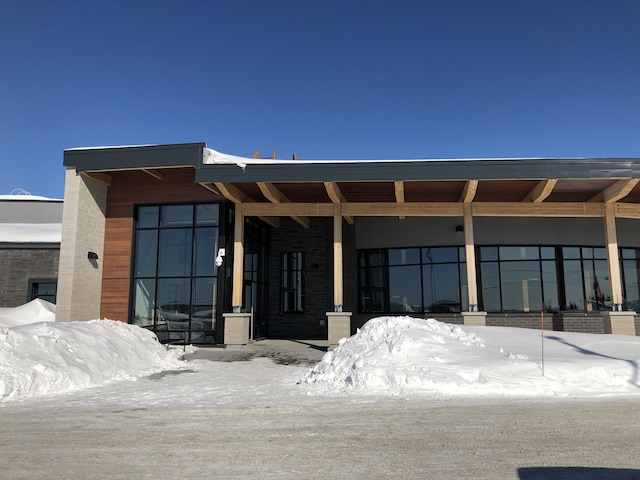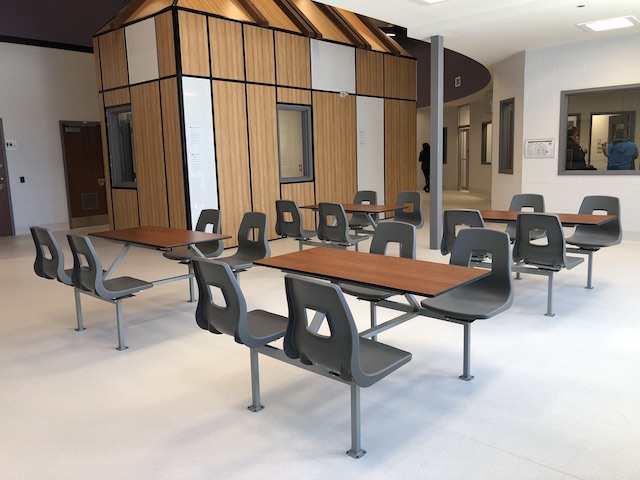“You’d assume a Cree would get lost on his own, 180 kilometres off trail… Actually, we get lost in the concrete jungles down south.”
Gerald Longchap, Mistissini Deputy Chief
Sunlight streamed through the gymnasium’s high windows during the inauguration of Mistissini’s Youth Healing Services Centre March 6, signalling a new era of compassionate treatment and rehabilitation in Eeyou Istchee. The Cree-engineered facility provides expanded capacity to meet the growing regional needs of youth justice in a culturally appropriate setting.
“This is another important milestone in our journey to self-determination, to reclaim our ability to take care of our youth in our own communities, in our ways, and in our language,” said Grand Chief Abel Bosum. “We hope this beautiful new centre will help inspire the ones who have stumbled along the path and became distracted from pursuing their dreams and aspirations.”
The Cree Nation Government and Cree Health Board (CHB) worked extensively with local, regional and governmental partners to develop the state-of-the-art building. Cree and Quebec officials were welcomed at the inauguration event, which included a lunch harvested by youth in the healing program.
“To help our children develop to their full potential is a collective affair and it is by working all together that we can do this as much as possible,” said Quebec Health and Social Services Minister Lionel Carmant. “Every child needs the chance to grow and better themselves in an environment that is safe and appropriate for their development.”

Flags outside the facility were flown at half-mast to honour the recent passing of a young community member. With Mistissini Chief Thomas Neeposh at the funeral, Deputy Chief Gerald Longchap spoke movingly about an epic snowmobile trip he’d taken the previous day to remind himself that he too had once lost his culture but regained it with the help of his family.
“As a non-Native, you’d assume a Cree would get lost on his own, 180 kilometres off trail,” said Longchap. “Actually, we get lost in the concrete jungles down south. Here we don’t need GPS because our grandfathers have taught us everything we need to survive. This [facility] is a tool for our youth to have that same privilege that I had.”
The residential facility will replace the current outdated reception centre, accommodating up to 20 boys and girls aged 12 to 17 who have been referred under the Youth Protection Act for intensive healing due to addictions, trauma or other serious issues. Besides nearly doubling this capacity, the centre will also receive youth in closed custody under the Youth Criminal Justice Act (YCJA), allowing them to complete rehabilitation programs within the Cree community for the first time.
“Our young people were subject to double hardship,” Bosum stated. “First, they were placed in custody for what they did; second, they were sent to be detained in the south, far away from their families and communities, and far from the healing power of the land. Their rehabilitation and reintegration was much more difficult.”

Bringing these young people home to Eeyou Istchee has been a long journey. Group homes in Mistissini and Chisasibi were created after troubled youth were first sent back to the Cree Nation in 1984. Reintegration services were transferred from Val-d’Or to the Cree Health Board in 1993 but no centre for these youth existed at the time.
“In the summer of 1994, they joined Elders on a canoe brigade, spending six weeks living on the land while the Cree Health Board made arrangements for a new reception centre,” recounted CHB chairperson Bella Moses Petawabano. “Around that time our old reception centre opened in 2001, our support model shifted from the house-parent model to the childcare model we have today.”
Under the house-parent model, Elders provided youth with a healing foundation of Cree values and culture, often spending 90 days out on the land with new arrivals. However, Elders weren’t equipped to handle the increasingly complex challenges faced by youth, such as drug issues, and their skills and knowledge weren’t as applicable to emerging institutional structures.
Land-based healing and other cultural aspects of the former model continue to flourish today, including pilot projects involving youth and their families taken on the land with educators and community Elders. Bush programs are ongoing at the group homes and the healing centre organizes regular “journeys of wellness”, nurturing connections to traditional Cree heritage.
Cree youth formerly detained in southern institutions will benefit most directly from these new services, receiving care in their own language with simplified visitation from family members. Youth in the four closed-custody and two intensive-supervision units will not mix with those in open custody, completing their activities and schooling within their unit.
Healing Centre workers trained in closed-custody units in the south to prepare for the youth who will begin arriving after additional fencing is installed this spring. A police escort will accompany them into the centre’s secure garage, where the youth will be thoroughly searched before entering their units.

“I visited youth down south – they weren’t feeling comfortable because they weren’t with their own people,” said Maria MacLeod, director of Youth Healing Services. “Compared to when I first started, we receive more difficult clients because of all the challenges our youth are getting today, the bullying they encounter as well.”
Programming for those in the open section will be similar to what now exists, gradually expanding to accommodate the more spacious facilities. Beyond the luminous gymnasium and outdoor basketball court are rooms for exercise, arts and other activities. While there are two classrooms in the centre, those in the open unit may also choose to attend public school in Mistissini.
The CHB is striving to develop services in close harmony with families, introducing new kinds of healing to ensure youth can remain in Eeyou Istchee. This “Family and Youth Empowerment” approach provides resources for early intervention to strengthen families and prevent unnecessary referrals to Youth Protection.
“Our challenge today is to continue to build on initiatives of this kind,” said Petawabano. “Our goal is to decrease the number of young people in foster care, to keep children close to their families. We look forward to a day when we will need to dedicate fewer resources to youth healing and instead focus on maintaining youth health.”





